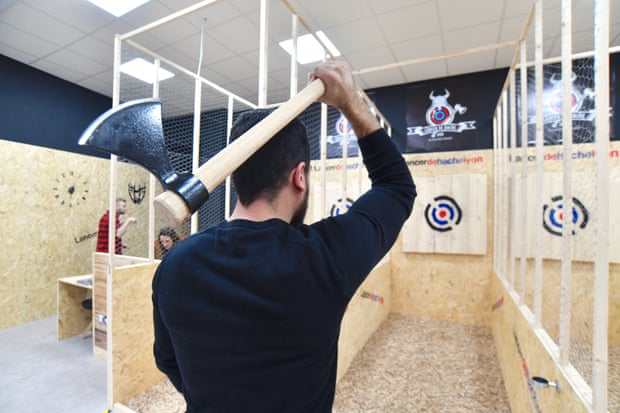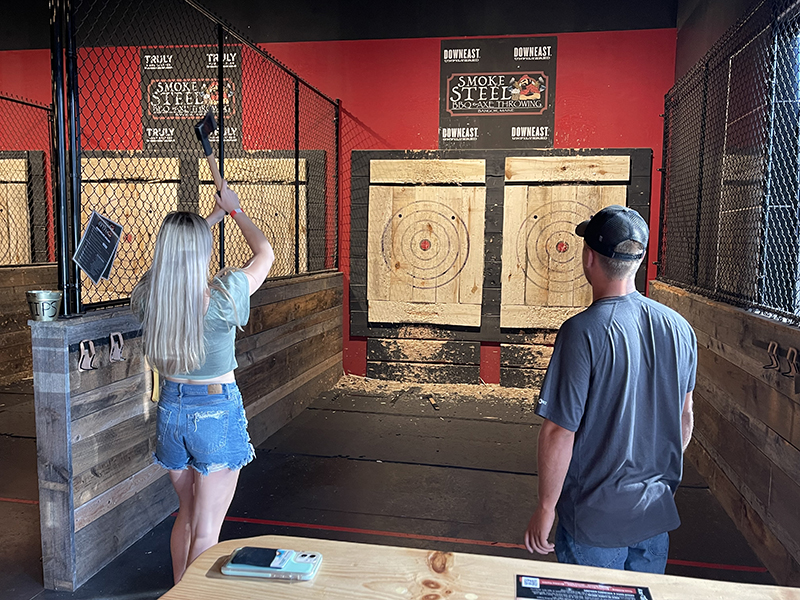Axe Throwing Denver Carbon Monoxide: Fun for Everyone, from Buddies to Families
Axe Throwing Denver Carbon Monoxide: Fun for Everyone, from Buddies to Families
Blog Article
The Enjoyable of Axe Throwing: Just How This Sporting Activity Incorporates Ability and Adrenaline for a Fun Time
Axe throwing has emerged as a mesmerizing sport that masterfully intertwines the requirement for exact skill with the rush of adrenaline, offering individuals a engaging and one-of-a-kind experience. The act of hurling an axe in the direction of a target requires focus and technique, at the same time cultivating an atmosphere of camaraderie and pleasant competition. This intriguing mix of mental focus and physical effort has actually made axe throwing a prominent choice for those looking for both entertainment and a feeling of success. To absolutely appreciate the depth and allure of this task, one must consider its beginnings, the essential tools, and the fundamental techniques that make sure both safety and pleasure.
The Origins of Axe Throwing
Axe throwing, an entertainment activity that has gotten considerable appeal in recent years, traces its roots back to ancient times. The earliest records of axe use in affordable contexts are discovered amongst the Celts and Vikings, that tossed axes for sport as well as in fight training.
Middle ages European warriors, particularly throughout the Center Ages, exercised axe throwing as part of their martial training. The Francisca, a kind of throwing axe made use of by the Franks, became legendary for its lethal precision. This conventional weapon was designed to be tossed at adversary guards and armor, showcasing its double energy in both sporting activity and battle.
In even more current background, axe throwing saw a revival in the logging camps of The United States and copyright in the 20th and 19th centuries. Lumberjacks would participate in friendly competition, testing their precision and toughness by focusing on wood targets. This evolution from a survival ability to an entertainment task has actually led the way for its modern rebirth, with devoted venues and organizations currently celebrating the sport internationally.
Devices You Need
Comprehending the rich history of axe throwing boosts the admiration of the sporting activity's contemporary version. For leisure and competitive axe tossing, the most typically used type is the hatchet, typically weighing in between 1.25 to 2 extra pounds with a manage length of around 16 inches.
Equally essential is the target. Guideline targets are created from timber, with softwood ranges like pine or cottonwood being preferred for their capacity to take in and hold the axe. The target is usually separated into 5 concentric circles, each with a details point value, to promote rating.
Safety equipment, however commonly neglected, is essential. Safety handwear covers can enhance grasp and stop blisters, while closed-toed shoes are a should to secure feet from dropped axes (denver axe throwing). Ultimately, a well-lit, roomy tossing area, complete with safety and security barriers, guarantees a regulated environment where individuals can focus on refining their skills.
Standard Techniques Explained
Grasping the essential methods of axe throwing is essential for both safety and effectiveness. The dominant hand must be placed straight below the axe head, while the non-dominant hand pop over to this site supports the end of the manage.
Your dominant foot should be slightly forward, straightening with your target. This positioning help in keeping security and directing power properly towards the target.

Safety First
Guaranteeing safety in axe throwing is extremely important to producing an injury-free and enjoyable experience. A well-designed axe tossing center functions clear demarcations between throwing lanes, strong backdrops to capture roaming axes, and non-slip flooring to avoid crashes.
Advantages of Axe Throwing
Axe throwing offers a myriad of advantages that extend past straightforward recreation. The repetitive movement of tossing the axe additionally improves hand-eye control and great electric motor skills.
Psychologically, axe throwing requires precision, strategy, and focus, making it a superb means to sharpen cognitive abilities. The focus required to hit the target can work as a type sites of mindfulness, enabling participants to remove their minds and decrease stress. This mental engagement can be particularly useful in helping individuals develop much better problem-solving abilities and mental durability.
Socially, axe throwing is typically enjoyed in group settings, fostering team-building and friendship. Whether as component of a business occasion or a laid-back outing with friends, the sporting activity motivates interaction and collaboration. In addition, the common experience of learning and improving with each other can enhance connections and produce lasting memories.
Final Thought

The from this source earliest records of axe use in affordable contexts are discovered among the Celts and Vikings, that threw axes for sporting activity as well as in combat training. Release the axe when your hands are roughly at eye level, enabling the axe's natural rotation to lead it towards the target.
A well-designed axe throwing center functions clear demarcations in between tossing lanes, strong backgrounds to capture roaming axes, and non-slip flooring to protect against accidents. Individuals should be instructed on the correct way to handle and toss the axe, highlighting regulated, calculated activities over forceful throws.
In summary, axe tossing stands out as a sporting activity that masterfully incorporates accuracy, skill, and adrenaline.
Report this page